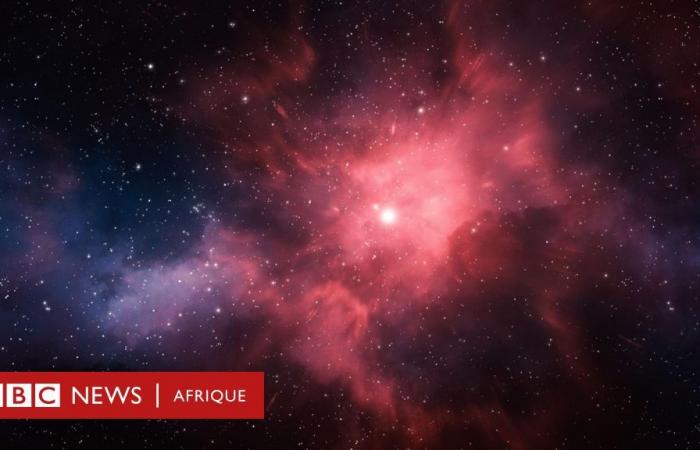Photo credit, Getty Images
11 minutes ago
The power of the James Webb Space Telescope was put to the test recently, with results that have intrigued even scientists.
The telescope detected objects in space that formed 12 billion years ago, relatively shortly after the Big Bang, which would have taken place 13.8 billion years ago.
These objects have never been detected before and challenge scientific understanding of galaxy formation.
Because of their luminosity in the red spectrum of the instruments used to observe them, astronomers have named these objects “little red dots”. But the definition of these objects is the subject of debate among scientists.
They look like small galaxies, about 3% the size of the Milky Way, but containing billions of stars.
They could also be galaxies containing a large number of black holes, a formation that has never been observed in the closest known galaxies to date.
It all depends on how these astrophysical objects are observed.
Some experts even compare their changing appearance to a kind of octopus that can change color and shape to camouflage itself.
They are “masters of disguise,” says astrophysicist Fabio Pacucci of the Smithsonian Institute in the United States.
Change in appearance
The little red dots “come from so far away that they arrive here very faintly,” astronomer Mario Hamuy, a professor at the University of Chile, told BBC News Mundo.
“They have typical sizes of 3,000 light years in diameter, or about 3% of the diameter of the Milky Way, for example, and have a very reddish color, which is explained by the fact that the light they emit was strongly modified by the presence of dust grains around them.
Photo credit, JWST/NIRSpec
Unlike home telescopes, large telescopes like the James Webb can capture light from very distant objects in the universe. The energy signals it receives can be picked up at different frequencies, which are analyzed in the form of spectra.
When the James Webb focused on the most distant points of the universe, he came across signals coming from “small red dots”, which had characteristics different from those of the astrophysical objects known so far.
Depending on how they are viewed on the spectrum, they exhibit characteristics that divide scientific opinion.
“All light sources in the universe change their appearance when you observe them in different windows of the electromagnetic spectrum. It’s like taking an x-ray image of your hand. In the first case, you will see a photo of your hand. In the first case, you will see the bones of the hand, and in the second, you will see the skin,” explains Mr. Hamuy.
“The little red dots are no exception. Depending on the spectral window you use, you will see different internal regions of the object,” he adds.
Like other objects in the early universe, these dots existed billions of years ago. Telescopes such as the James Webb have been detecting light that has passed through space since then.
It is because of these differences in the analysis of the spectra that scientists observed different characteristics in these small red dots: sometimes a galaxy housing millions of stars, sometimes a galaxy with a supermassive black hole.
“We don’t see this type of galaxy in our nearby universe. “It’s something that appeared at the beginning of the universe, that lasted for a while and that we don’t see anymore today,” astrophysicist Begoña Vila, an instrumentation engineer at NASA, told BBC News World.
“When we started looking at them, we first thought it was another object. Today we know that these are galaxies and that is very exciting for everyone.
Because they are different and are “masters of disguise,” these objects challenge the models that scientists have developed to explain the origin of galaxies.
Rethinking what we know
What’s surprising about these objects, Vila explains, is that it’s not clear how they can fit so many stars – a number perhaps similar to that of the Milky Way – in such a small space. , astronomically speaking.
“How so many stars formed so quickly remains a question mark,” he adds.
Mr. Pacucci explains that in these galaxies, there are so many stars in such a small space that it is as if the entire population of China were placed in one room.
We can therefore ask ourselves whether the models available to scientists to explain the formation and composition of galaxies in the early stages of the formation of the universe are correct.
“Existing models of galaxy formation so far explain very well what we have around us, the nearby galaxies, but there are already indications that they need to be modified to explain this primordial universe, these galaxies” , says Vela.
Photo credit, NASA/ESA/CSA/STSCI/BRANT ROBERTSON ET AL
Likewise, if the little red dots are actually galaxies with a supermassive black hole, scientists’ understanding of their formation will need to be rethought. But not to the point of modifying the main theories, explains Mr. Vila.
“(At first) we felt like the cosmology was broken and we thought we needed to change it. But that wasn’t the case. The Big Bang is always perfect, there is no problem,” explains the NASA expert.
“What happened was that the models we had so far were based on the data we knew and reflected what we knew so far. But it is clear that this primitive universe holds surprises and that is what James Webb was designed for. »
What is happening now?
Since identifying the little red dots and discovering their change in appearance, scientists have continued their studies with new models and instruments to observe them.
It is hoped that in the coming years, researchers will have a theory capable of explaining what they are and how they formed.
For Vila, the most appropriate answer may not be to define whether they are galaxies with millions of stars or supermassive black holes: “It could be a bit of both theories “.
But it will also allow scientists to learn more about the formation of the universe from phases that, until the launch of the James Webb Space Telescope, were little known.
“The most surprising thing is that the little red dots are very abundant. If these were active galaxies, they would outnumber quasars by a factor of ten [galaxies très lourdes] detected by traditional methods,” explains Mr. Hamuy.
He adds: “In all cases, the small red dots are crucial for understanding the initial formation of galaxies.”






